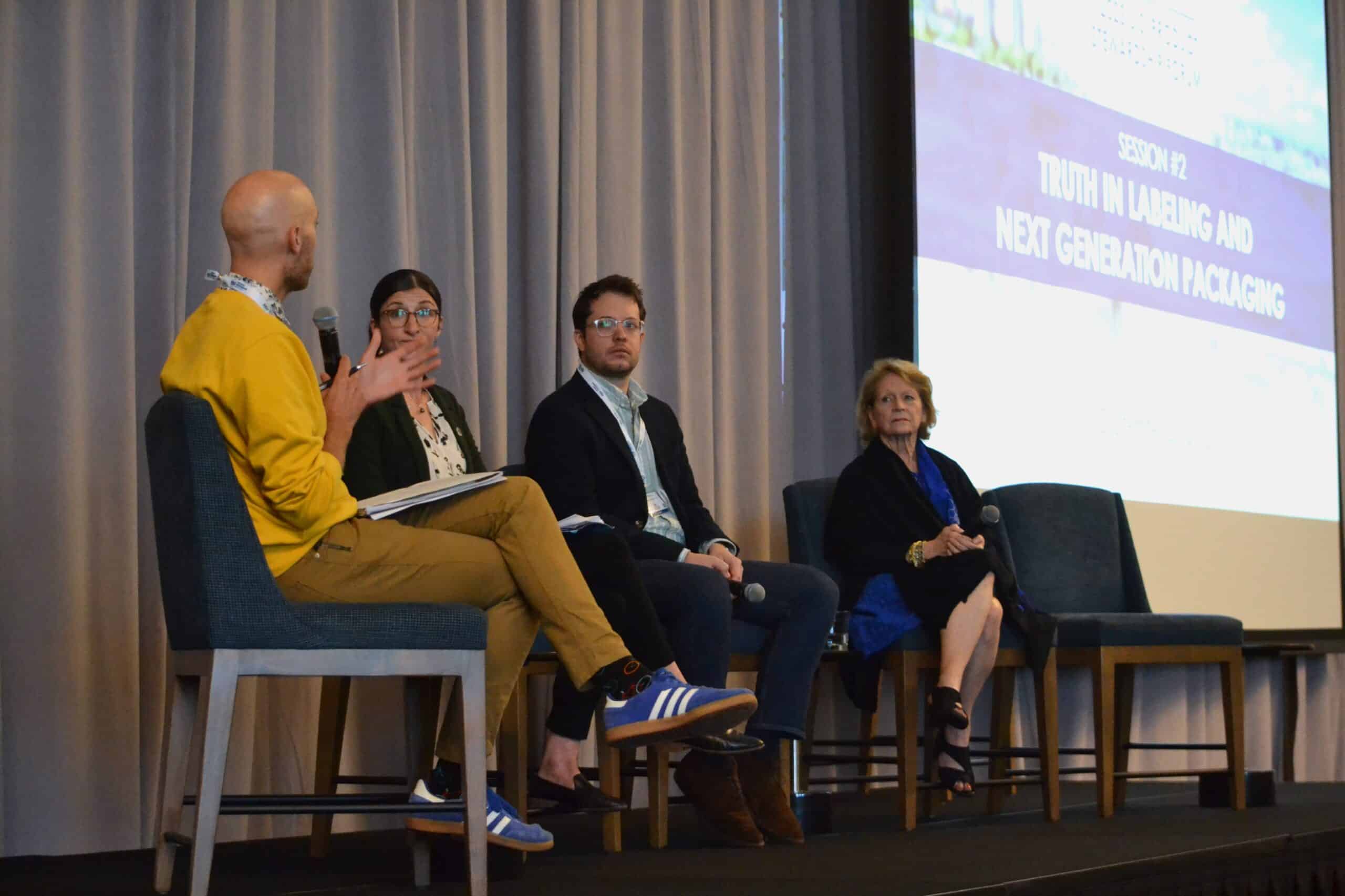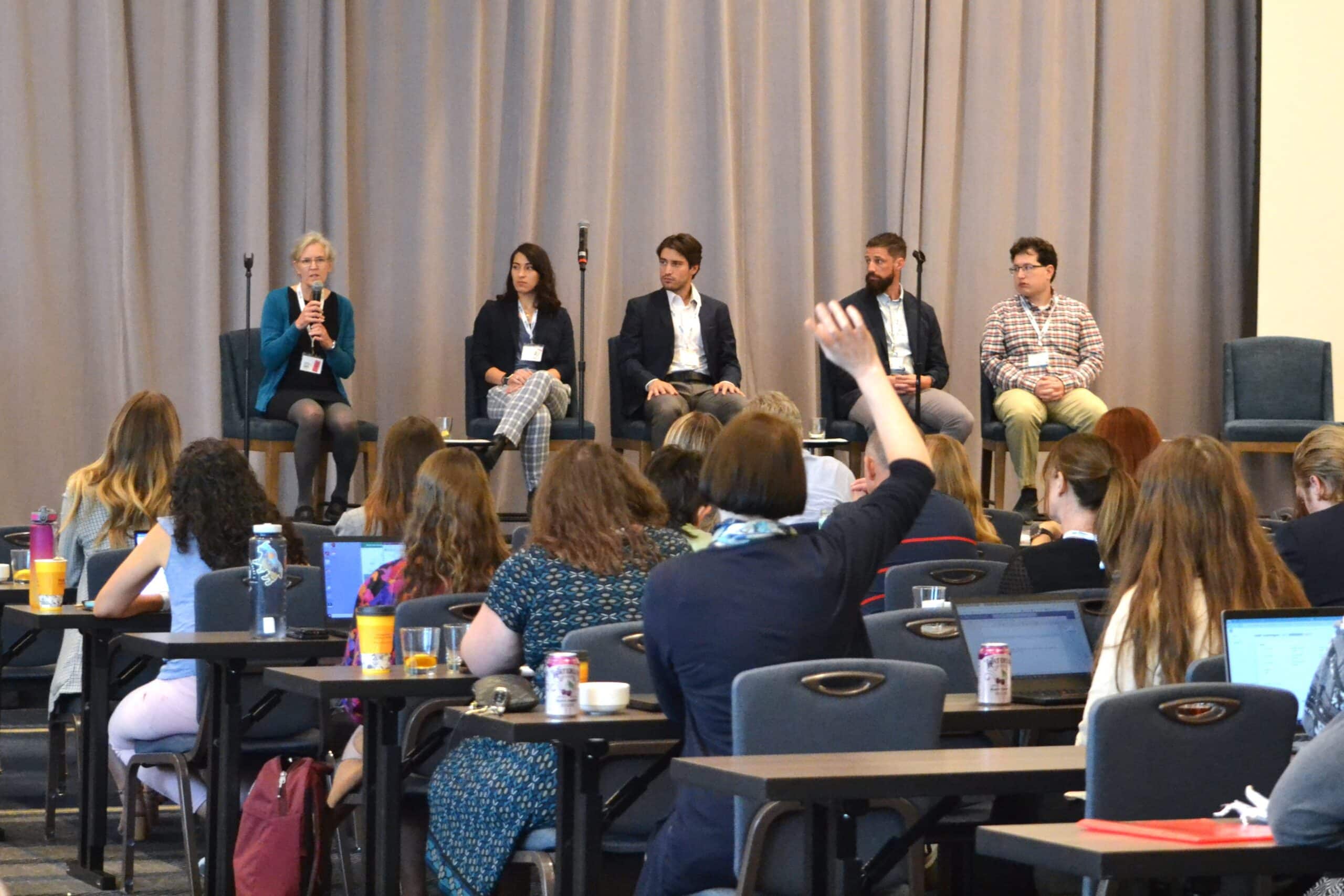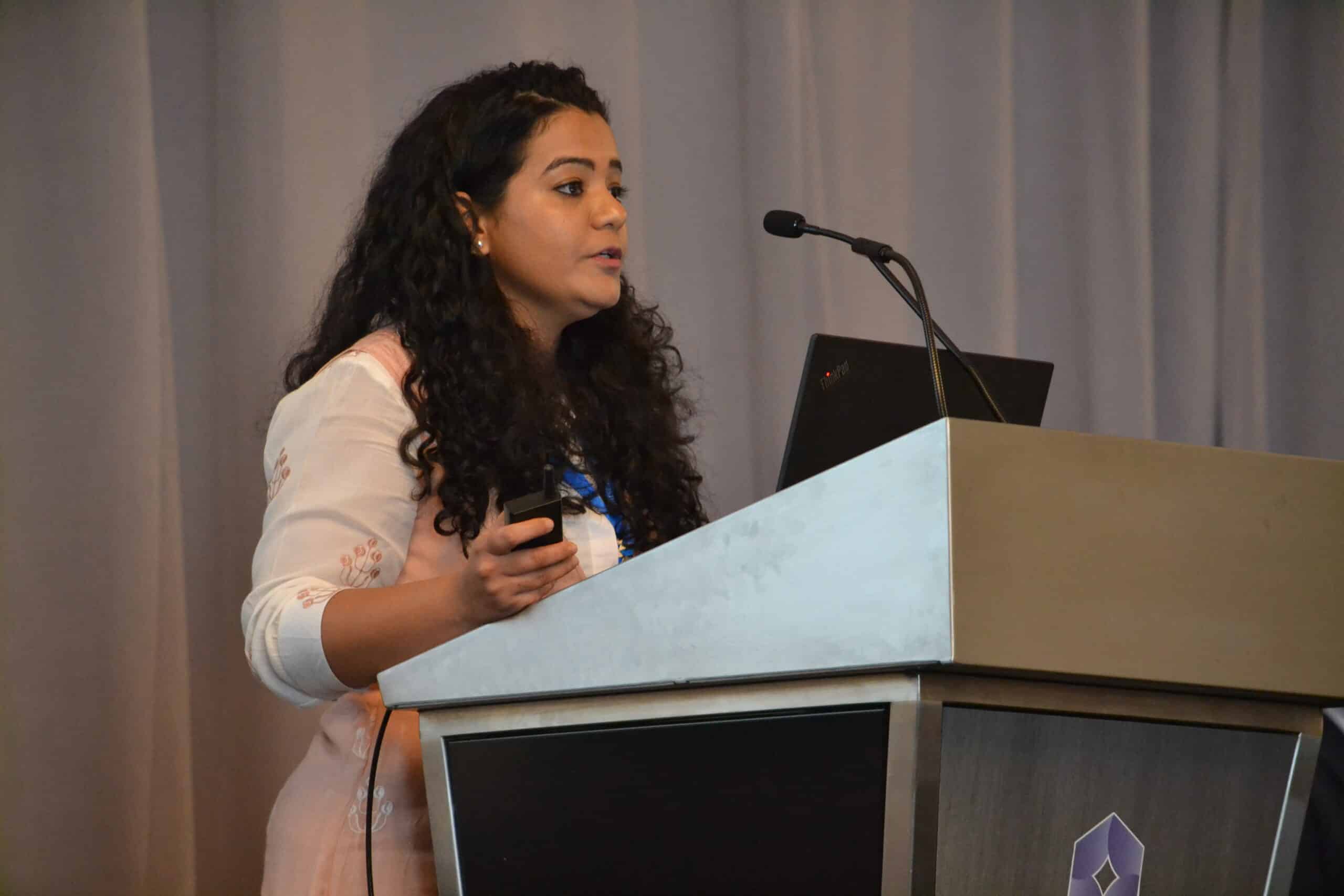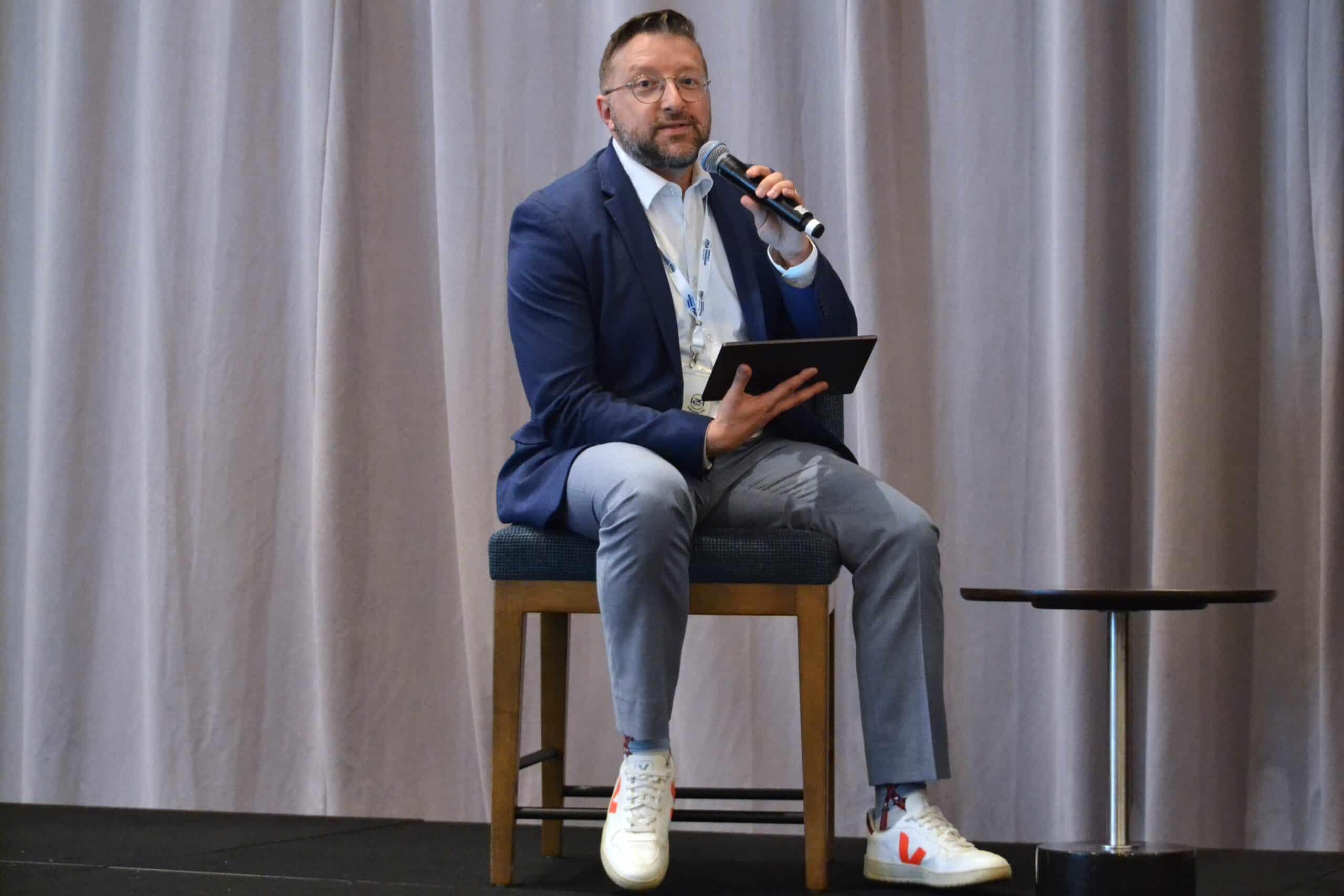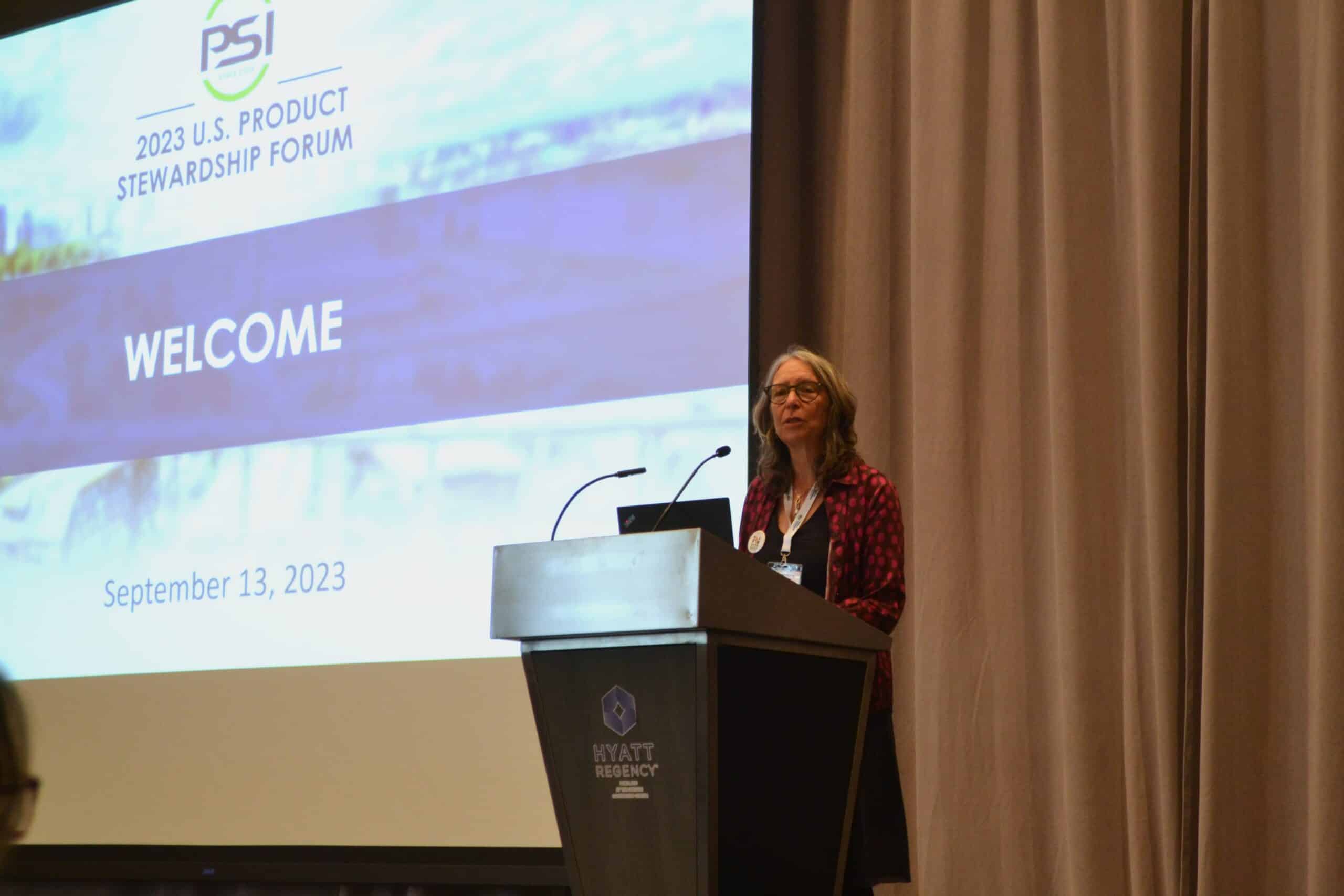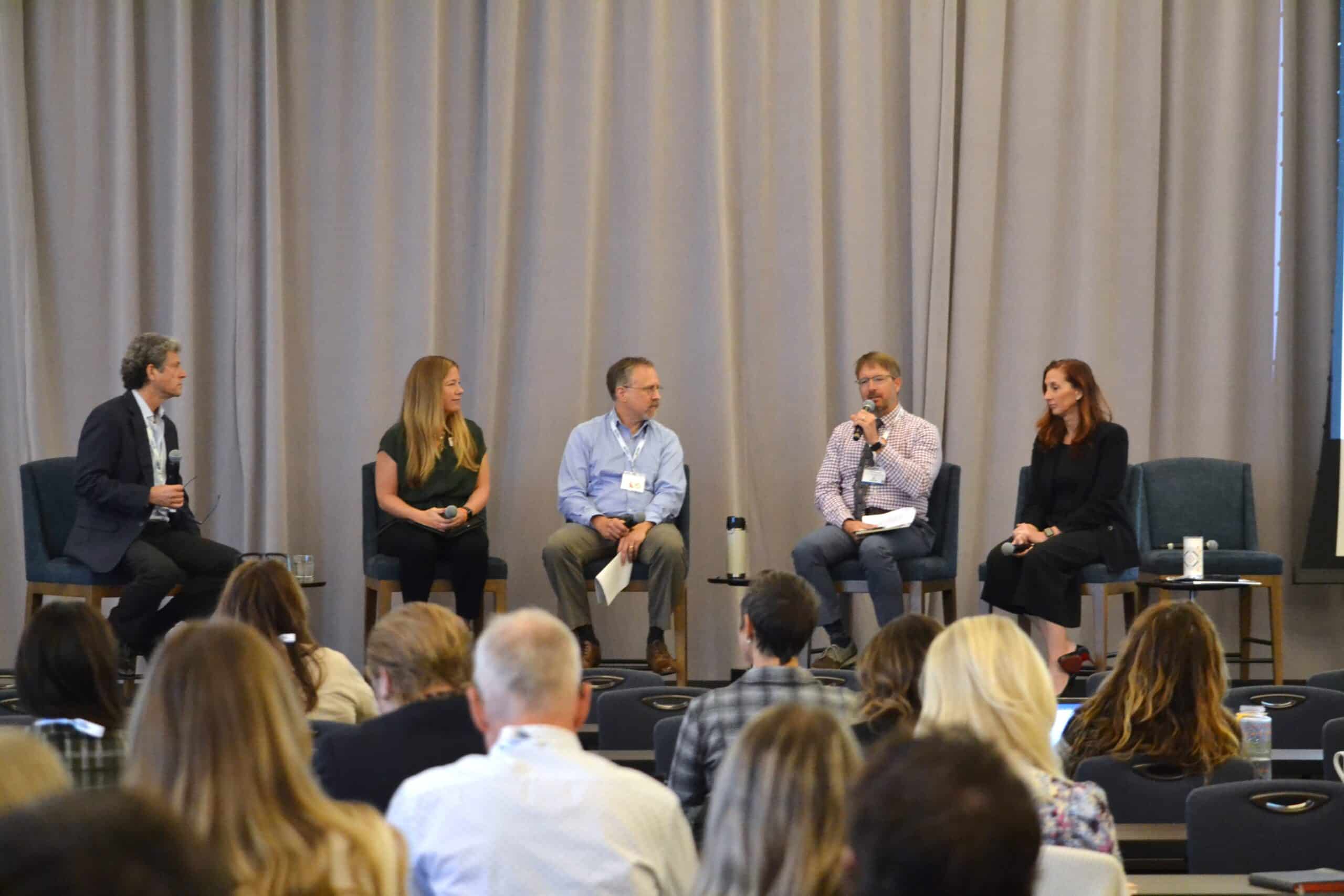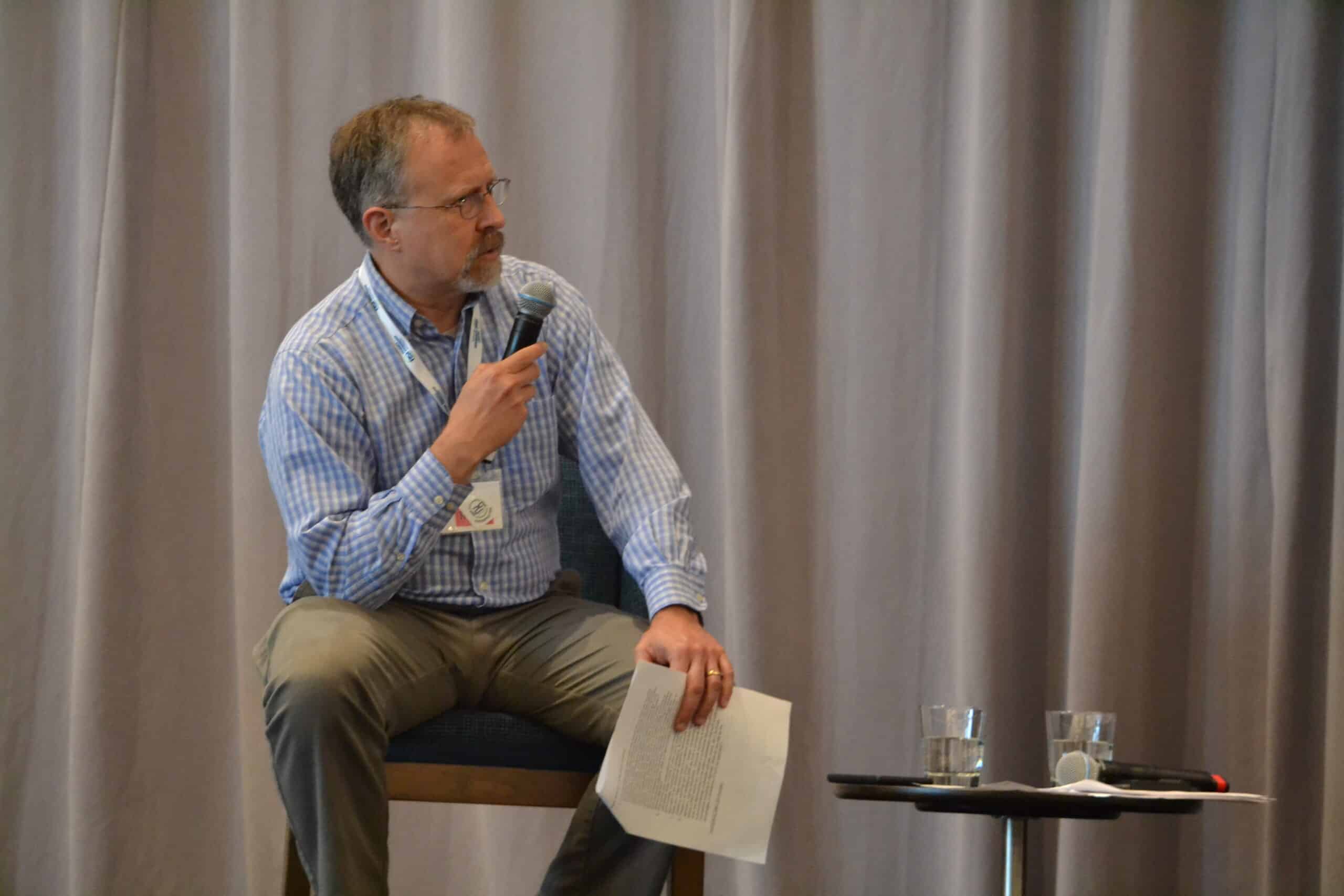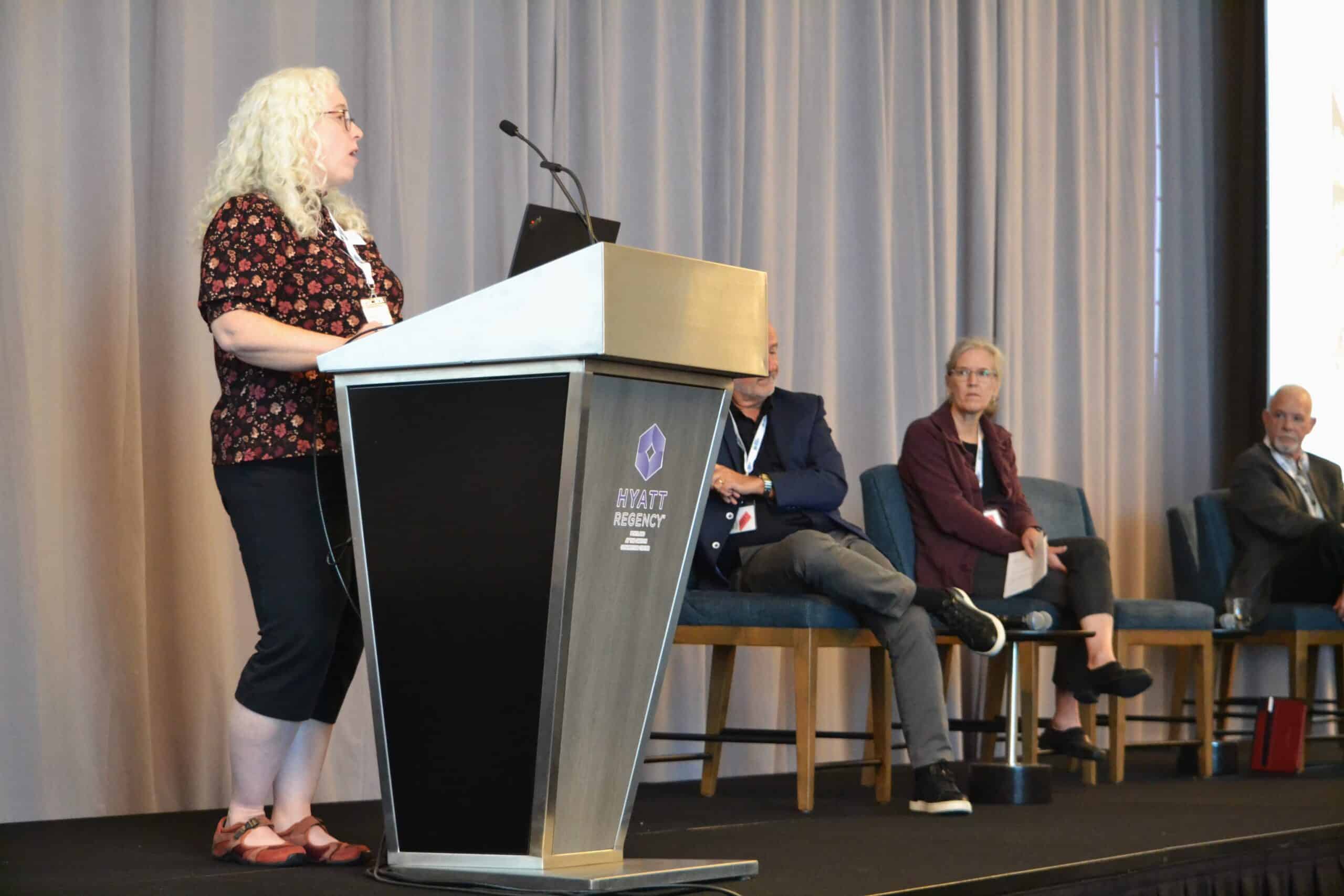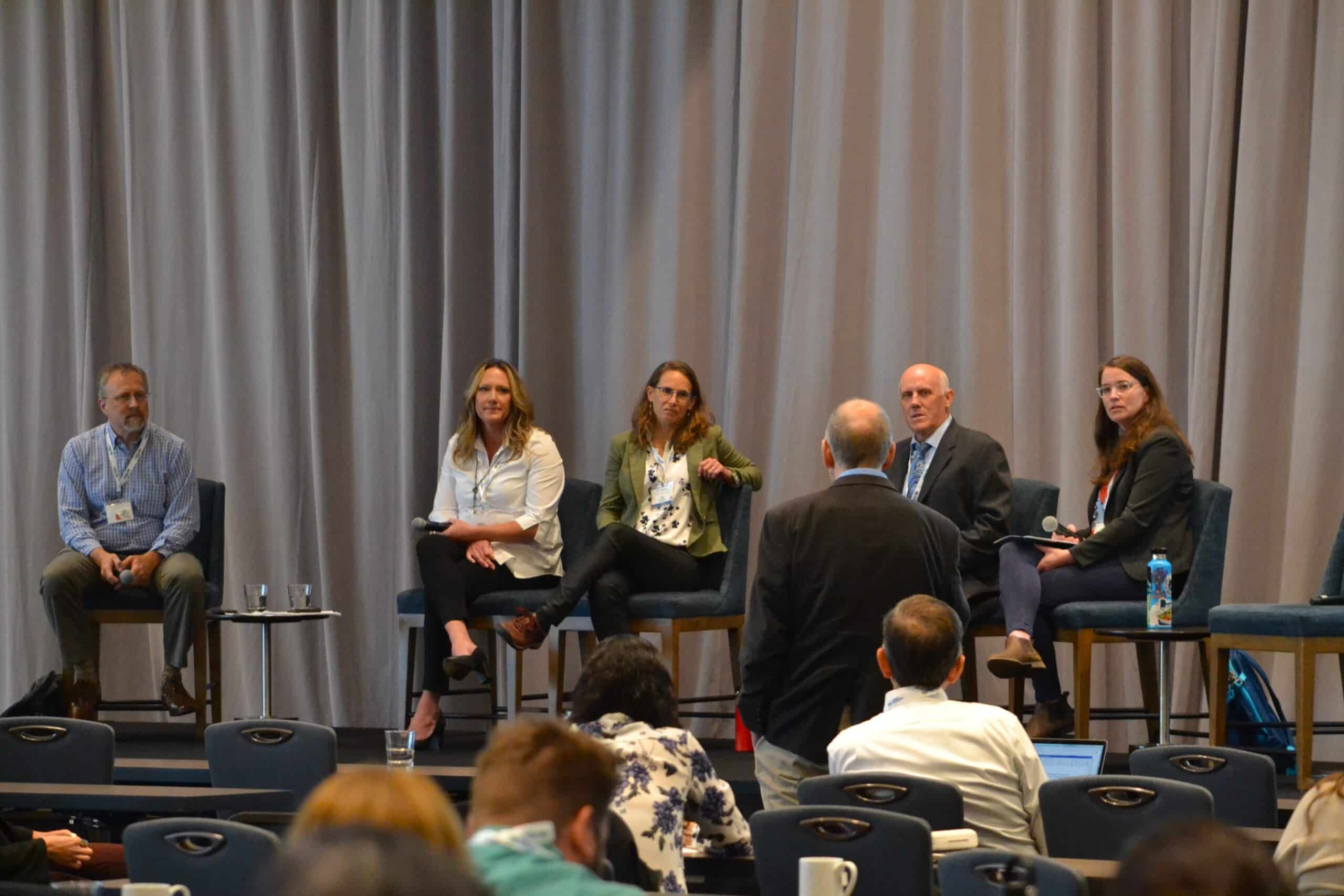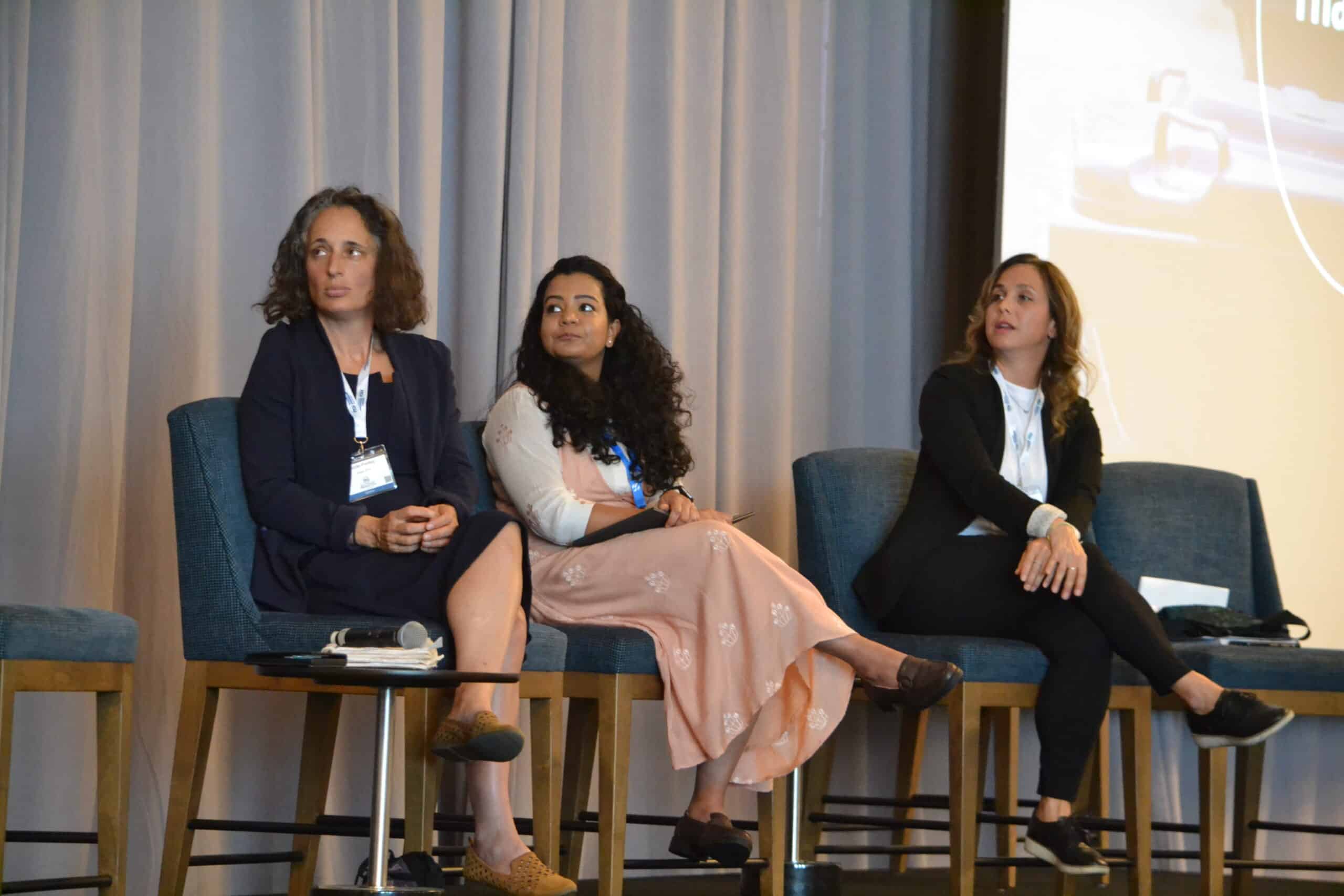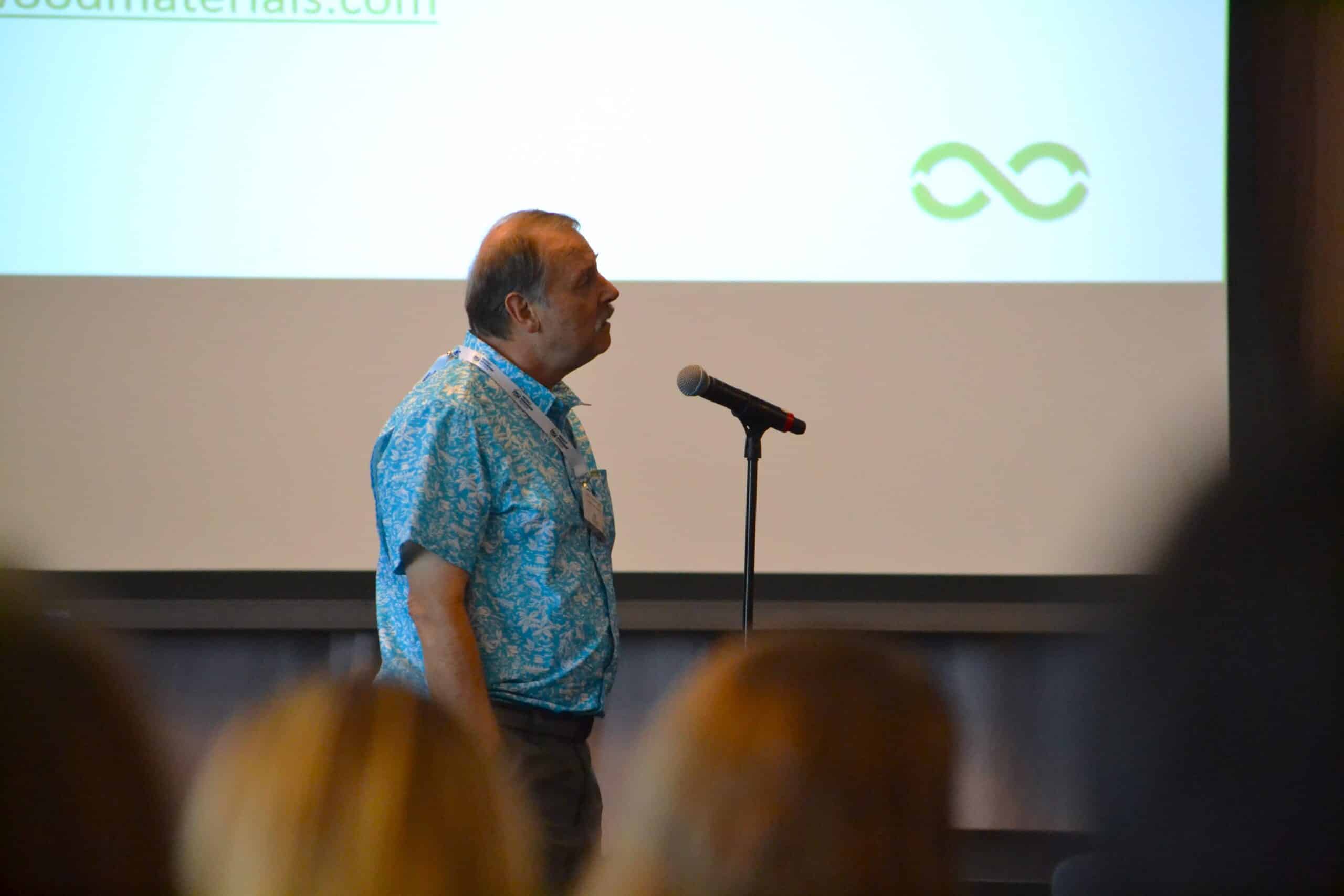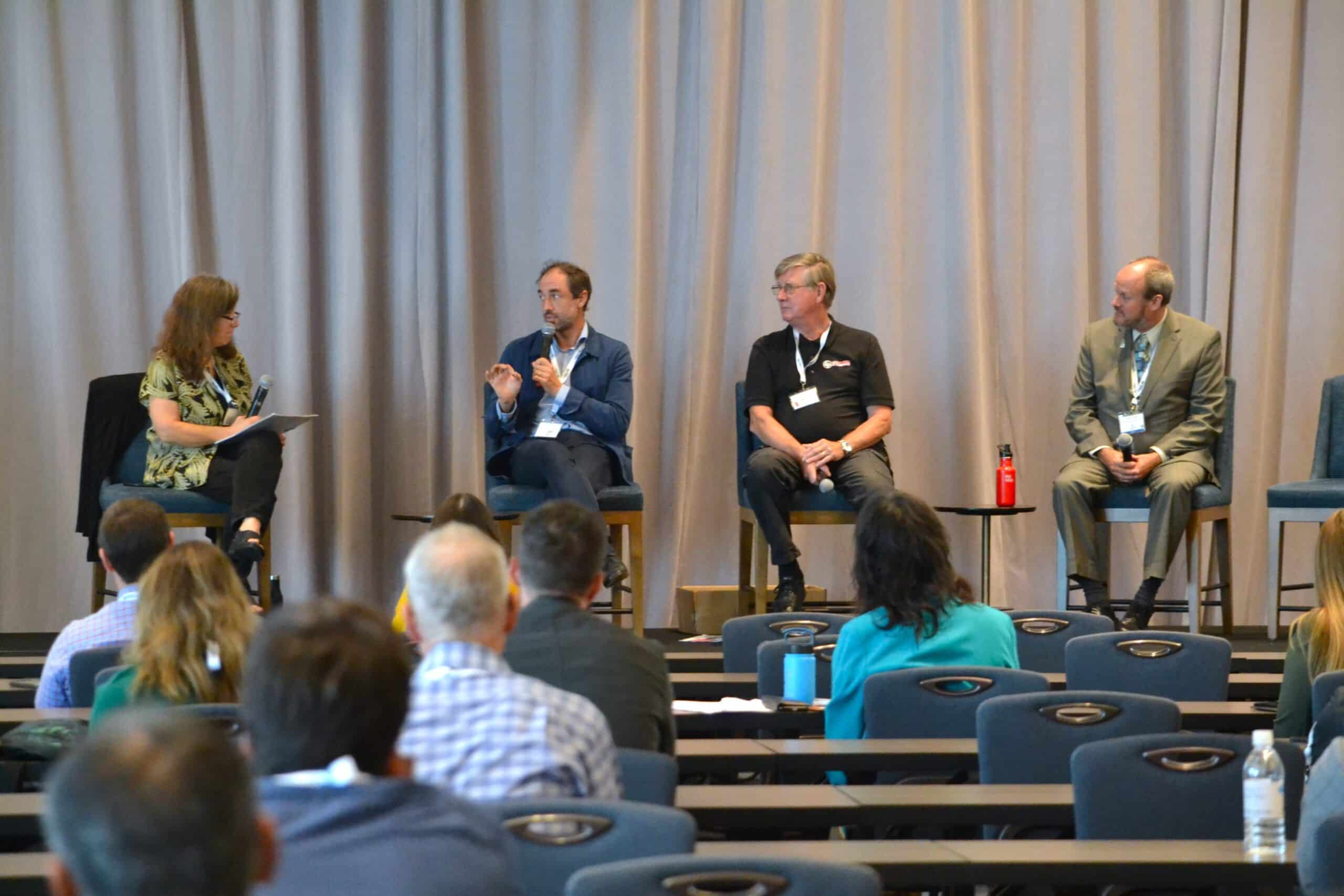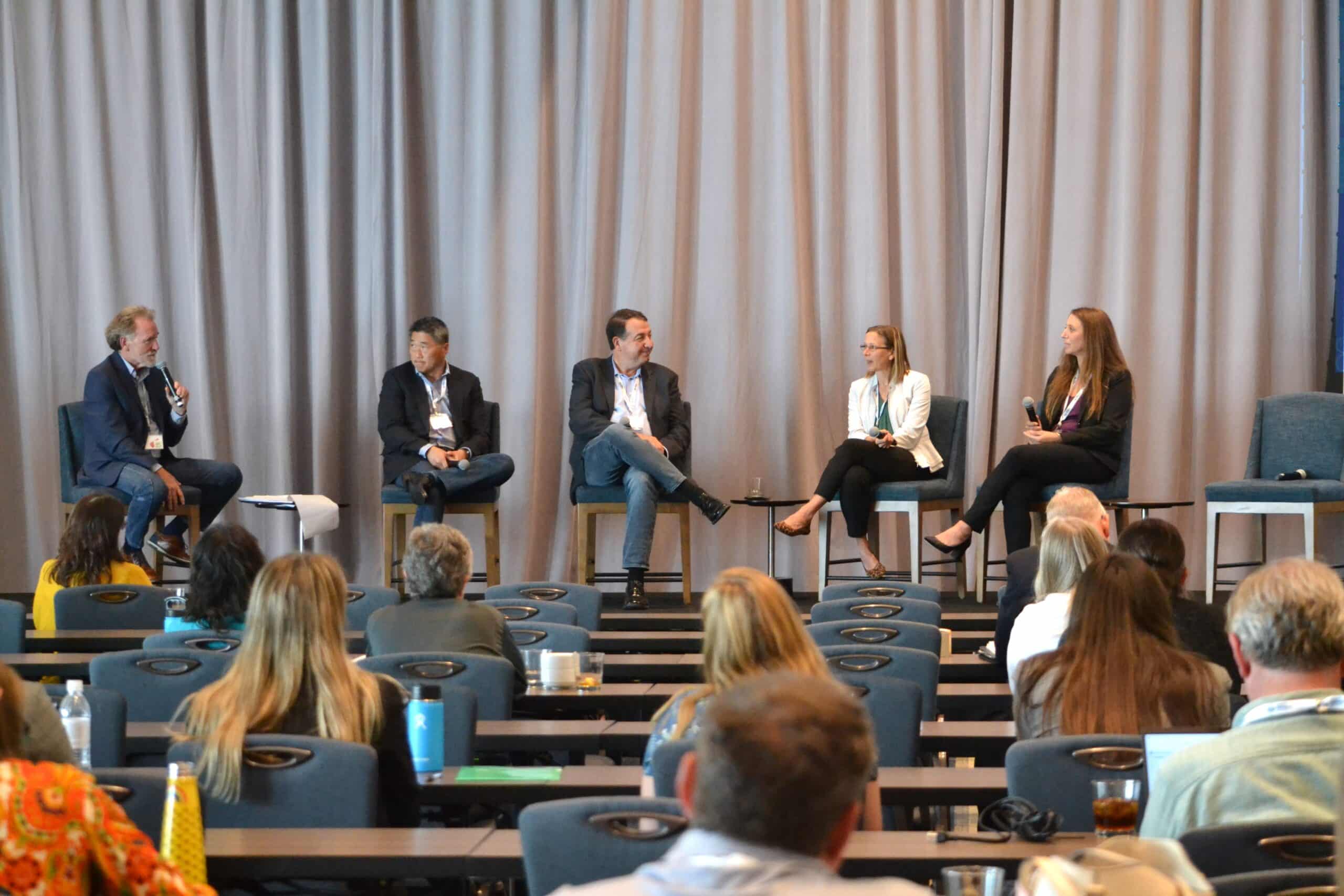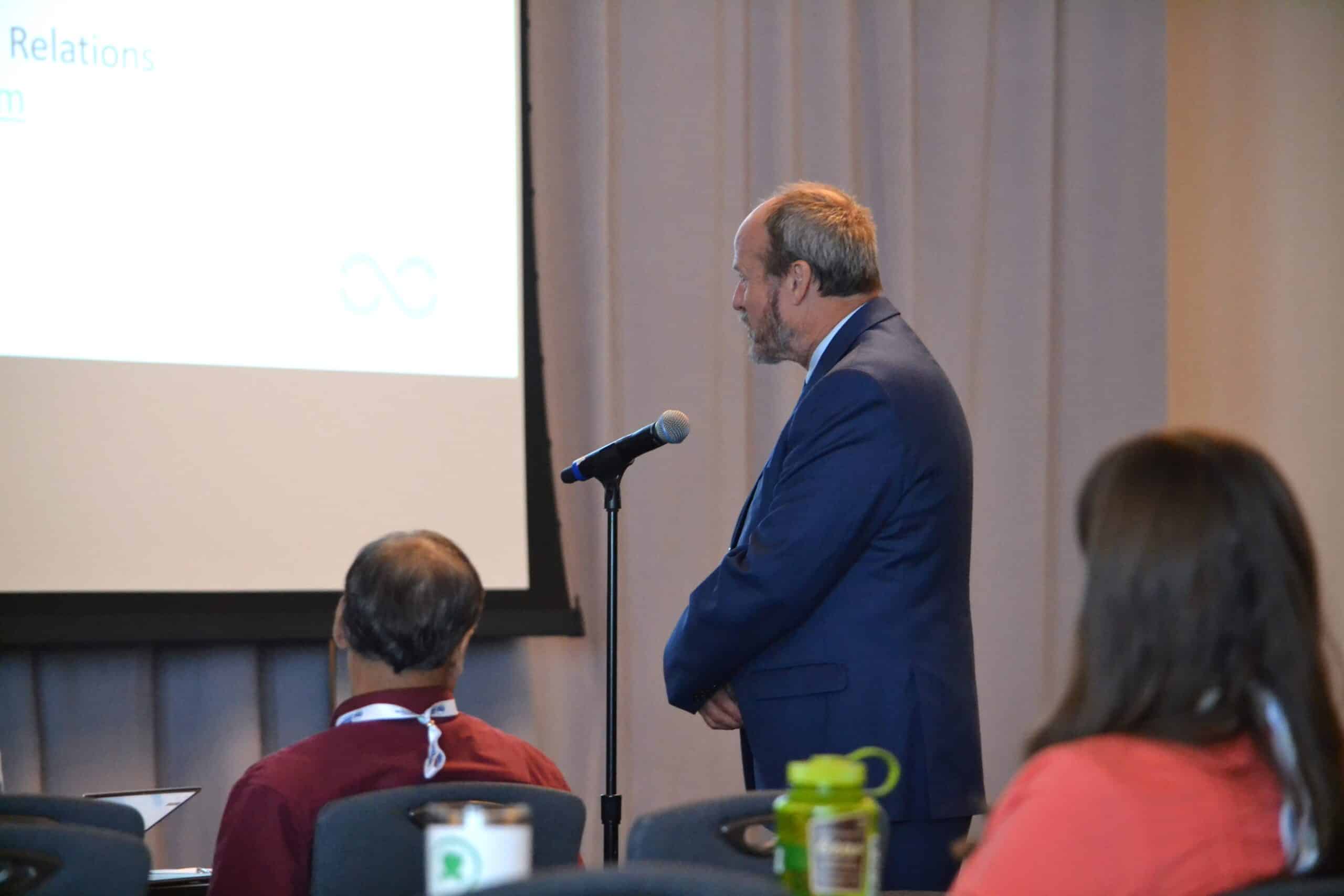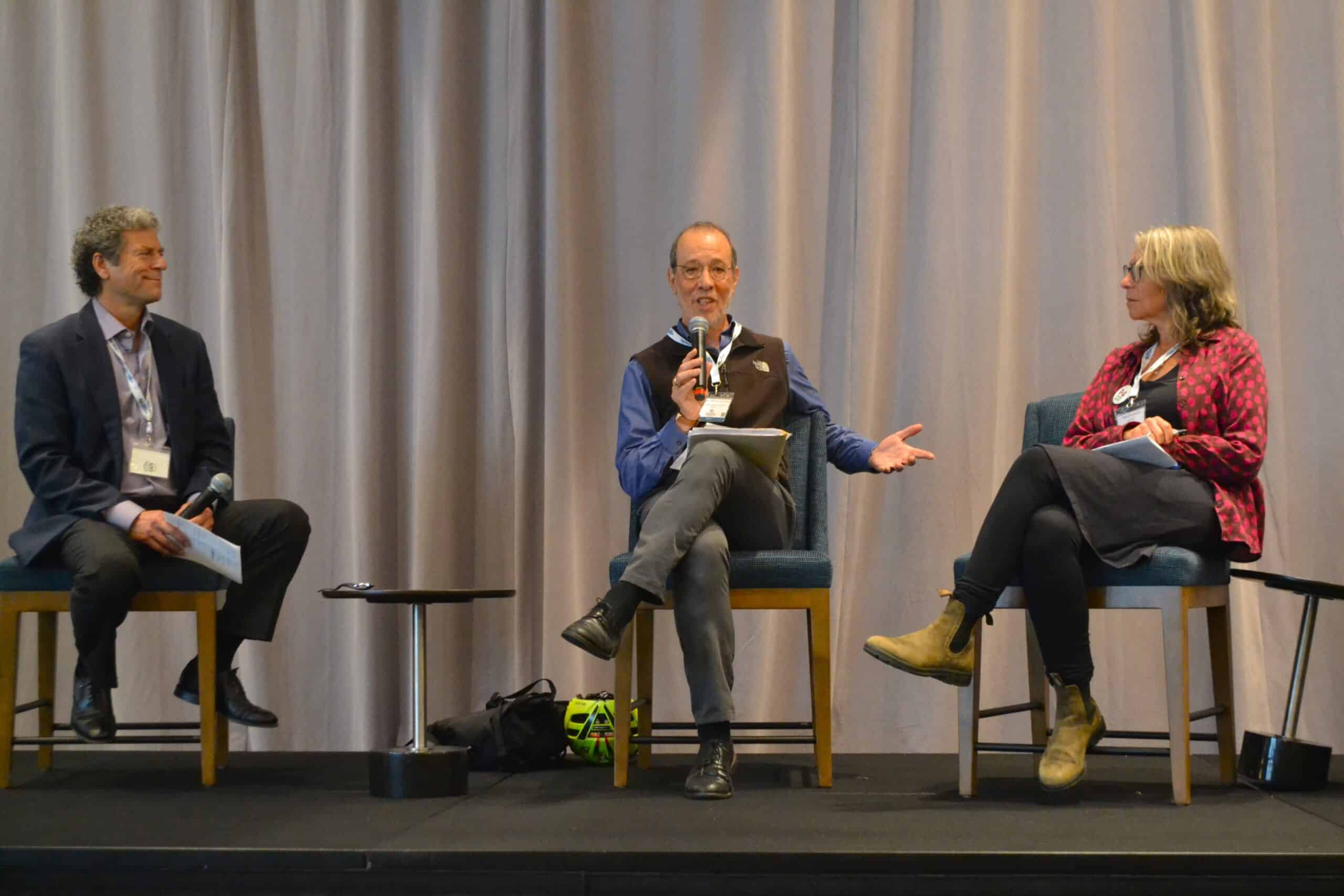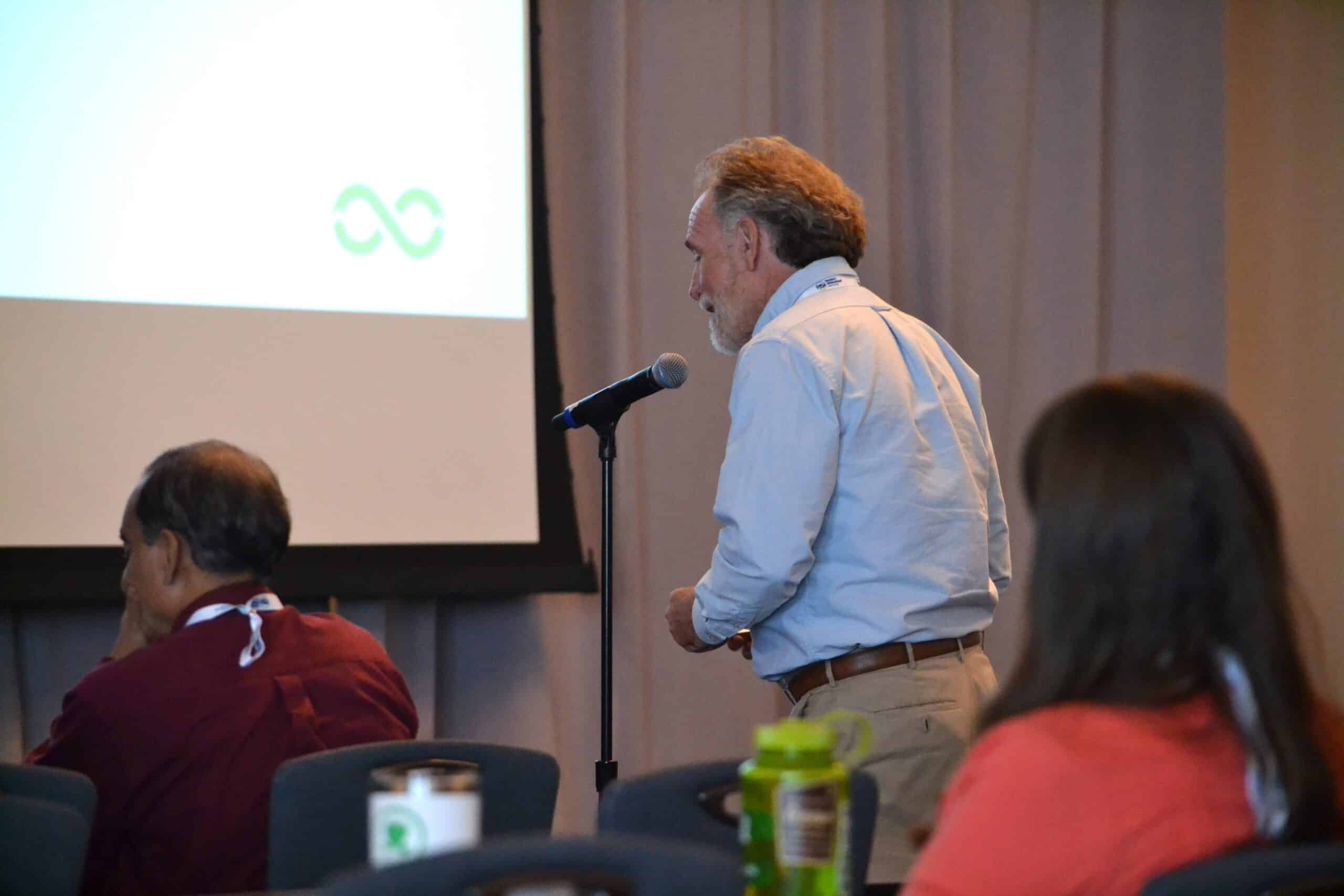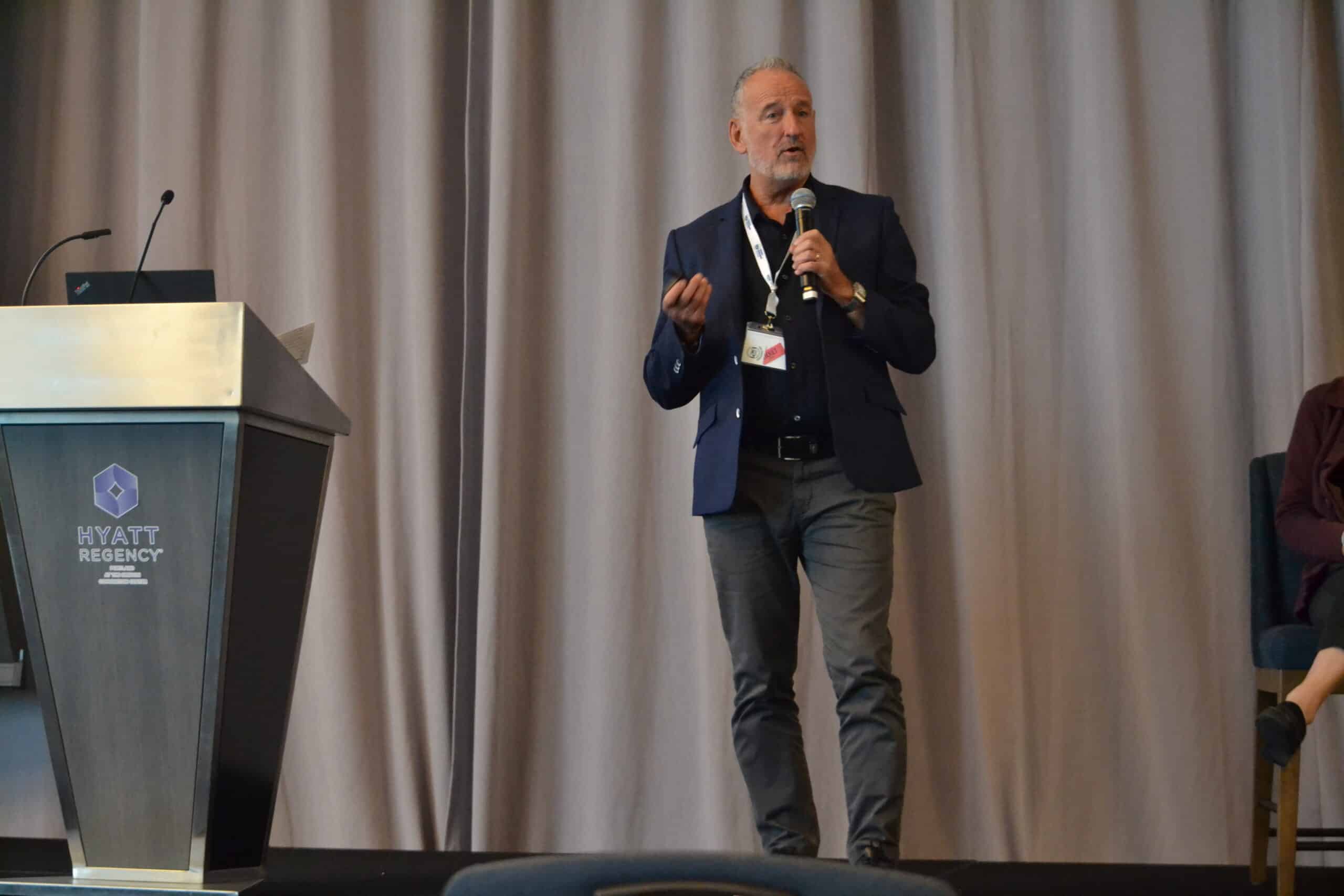Earlier this month, over 200 globally recognized experts gathered in Portland, Oregon for PSI’s 12th U.S. Product Stewardship Forum. Speakers presented throughout two days of intensive sessions on a wide range of topics covering the most important trends in producer responsibility policy and programs. While all of the sessions were insightful and high quality, the following notable quotes were made during a few of the top sessions.
Extending Responsibility: Eco-Modulated Fees and Responsible End Markets
“Eco-modulation must go beyond incentives, it is about making sure the fee structure reflects the real costs of managing the packaging material and its impact in the value chain.”
Genevieve Dionne, Éco Enterprise Quebec
“Eco-modulation works, period. But it could be gentler, and it could be less complicated for the producers and other market players.”
Gauravi Saini, Reclay StewardEdge
Perspectives on Plastic Recycling – From Mechanical to Chemical
“Mechanical and chemical recycling need to be complementary solutions. The complexities of plastic waste require both to deliver a truly circular economy”
Maranda Demuth, Eastman
“We need to have a robust conversation on whether chemical recycling is worth its environmental impacts.”
Celeste Meiffren-Swango, Environment Oregon
The PRO’s Role in the Circular Economy
“Having a not-for-profit producer-governed organization that supports producers in meeting their EPR commitments ensures efficient and effective recycling systems are in place where plastics and other packaging materials are collected, recycled, and returned back to producers for use as recycled content.”
Allen Langdon, Circular Materials
“We are working with local governments and recyclers to determine how to effectively support recycling systems.”
Shane Buckingham, Circular Action Alliance
“The hallmark of successful systems is a focus on the goals and the desired outcomes.”
Leslie Huska, GreenDot North America
Packaging EPR Implementation in the United States
“The Oregon law prioritizes sustainability above circularity. There is potential for these ideas to be in conflict and the Oregon law aims to achieve broader sustainability objectives. If we pursue circularity in a narrow way and just focus on recycling and composting, there might be some unintended outcomes.”
David Allaway, Oregon Department of Environmental Quality
“In California, we are focused on the reduction of plastic pollution and overall production of packaging materials in the state. The California law requires that 100% of packaging sold into the state of California is either recyclable or compostable, by 2032.”
Rachel Machi Wagoner, CalRecycle
KEY TAKEAWAYS
Throughout the rich and diverse discussions at the conference, the following important issues were highlighted as they are becoming increasingly important in the field of EPR.
- Policy Harmonization: All stakeholders expressed the importance of identifying common elements of all EPR bills and laws. Policy harmonization is not only crucial for increasing the efficiency of existing and future programs, but also for ensuring alignment across jurisdictions, reducing consumer confusion, and enabling effective program comparison.
- Measuring Success: Congruent with the need for policy harmonization is the need to define how the success of a program or policy is measured. It is essential to identify what needs to be measured, ensure that data collection is accurate and consistent, and provide all stakeholders with relevant information.
- Producer Presence: As the field of EPR continues to advance, it will be necessary to directly involve producers, along with associations, in the conversation. Without representation from key producers, a valuable perspective on the field is lost. The interest of individual producers and their associations are essential to advancing effective EPR policy.
WHAT ARE PEOPLE SAYING ABOUT THE CONFERENCE?
We are shifting into a new phase of the EPR movement with rapid success and the need for engaged stakeholders and a highly knowledgeable community. The PSI Forum will continue to be a space for those eager to learn and contribute as we lead this movement forward. Here are some thoughts from 2023 PSI Forum attendees on the importance of event:
“PSI did it again, assembling the world’s experts on EPR (those actually engaged in making it happen) and presenting two days of rich, productive conversations about the current state of affairs in the U.S., Canada and Europe and where things are headed, on a wide variety of products as well as packaging. Kudos to PSI for being able to bring such diverse parties to the conference in a series of stimulating panels. PSI continues to be THE place to go for expertise, ability to bridge government, business and advocacy groups, and the many connections, contacts and synergies possible.”
Dave Galvin, former PSI board president
“PSI’s conference enables State Environmental Staff, PROs, Recyclers and NGOs to collaborate on EPR. With the growth of EPR, this conference is becoming essential to those involved with environmental policy and execution.”
David Bender, CEO Circular Polymers by Ascend
“Excellent forum about all aspects around EPR. Competent speakers, lively discussions about the hot topics, engaged participants, perfect networking. The place to go in the US!”
Joachim Quoden, Managing Director EXPRA
“The 2023 US Product Stewardship Forum provided a wonderful opportunity to connect and have meaningful and in-depth conversations with others working to find solutions to how we can move the solid waste industry from a linear (extract, make, use, dispose) system to a more circular economy. Learning from each other and working together, we can take actions that have long-term positive results for our customers and the environment!”
Susan Fife-Ferris, Seattle Public Utilities, Washington
“Fun, productive, and a truly unique meeting of the minds from across the globe!”
Maya Buelow, Lane County Waste Management, Oregon
“Scott and the PSI team put together an excellent event. The structure was just right to allow attendees to choose which sessions they wanted to attend without having to choose from overlapping sessions. Looking forward to the next Forum two years from now!”
Doug Kobold, California Product Stewardship Council
CONTINUE THIS WORK WITH US
PSI will continue to lead these conversations with other experts through our webinar series this fall. Our webinars will cover a range of pressing issues and we look forward to your participation. For more information, sign up for our monthly newsletter.
BOOK NOW AVAILABLE
Scott Cassel, CEO and Founder of the Product Stewardship Institute, debuted his recently published book, Perspectives on Product Stewardship: Navigating an extended producer responsibility path to a circular economy, at the 2023 U.S. Product Stewardship Forum. This book is a must-read for all EPR professionals. Click here to purchase your copy! If you are a PSI Member or Partner, contact info@productstewardship.us for 30% discount.
PHOTOS FROM THE FORUM:
by the team at PaintCare, a PSI Partner
PaintCare, the nonprofit organization that plans and operates paint stewardship programs in states that pass the paint stewardship law, is proud to celebrate one year in New York. The New York PaintCare program launched on May 1, 2022, and has been providing more convenient paint recycling in the state over the past year. To date, PaintCare has collected 727,000 gallons of paint for recycling in the state.
PaintCare operates programs in 10 additional states and jurisdictions including CA, CO, CT, DC, ME, MN, OR, RI, VT, and WA. In these states, paint recycling is made more convenient for households, businesses, contractors, and others with unwanted, leftover paint. In New York, there are 285 drop-off sites open year-round for paint recycling, and 2,450 drop-off sites across all program states. This resource benefits all community members and is available across the state, including in New York City.
To find a drop-off site near you, use PaintCare’s drop-off site locator to find the most convenient options to recycle your unwanted paint. PaintCare also offers a large volume pick-up service (LVP) for anyone with 100 gallons or more of paint, measured by container size, not liquid volume. These resources are available to anyone in all PaintCare states who wish to responsibly recycle leftover paint.
PaintCare keeps paint out of the waste stream by offering convenient ways to manage it by offering tips on using up leftover paint and providing drop-off sites and events in which communities and businesses can drop off unwanted paint. To date, PaintCare has collected over 64 million gallons of paint for recycling across the country.
For more information about paint recycling and to contact your local representative, visit PaintCare online at www.paintcare.org or call them at (855) PAINT-09.
Follow PaintCare on social media @WeRecyclePaint on Facebook and Instagram!
by the team at Covanta, a PSI Partner
In the United States, we still bury more than half of our waste in landfills, losing valuable resources and harming the environment in the process as those materials release exorbitant amounts of methane into the atmosphere and contaminants into our soil and waterways.
On the surface, sending waste to landfills may seem to be the easiest and most economical route to waste disposal. But aside from the hidden liabilities and harmful effects, the upfront cost of landfill disposal is steadily rising as landfill space becomes ever more scarce. According to the Environmental Research & Education Foundation, landfill tipping fees increased annually on average between 5% and 7% — measurements taken before the sharp rise in supply chain issues and inflation.
By adopting zero waste-to-landfill processes and policies in order to divert waste away from landfills, companies can do more to preserve the environment and bolster their bottom lines: They can reduce logistics expenses and landfill fees, improve environmental compliance and reap positive public relations benefits.
This can all be accomplished by reducing the amount of waste your business generates, amplifying your recycling efforts, and finding sustainable solutions that extract value from the materials that remain.
Visit Covanta’s blog to learn the four steps that can help companies create an effective zero waste-to-landfill plan.
by Rachel Lincoln Sarnoff, Marketing and Communications Director
PSI CEO and Founder Scott Cassel recently joined two expert panelists for a webinar discussion of EPR that was hosted by the U.S. Environmental Protection Agency’s Trash Free Waters program.
PSI and US EPA have a long history. Beginning in 2003, we worked together to facilitate a multi-stakeholder dialogue — which included industry, government, and recycled paint manufacturers — and to develop a legislative model for paint EPR.
The mission of the Trash Free Waters program is to protect human health, aquatic ecosystems, and the economy by partnering on collaborative solutions to reduce the volume of trash — especially plastic materials — polluting our rivers, lakes, estuaries, and oceans. Because of this, the focus of the discussion was packaging EPR. Scott was joined by Kelly McBee, Circular Economy Senior Coordinator at As You Sow, and Maine State Senator Nicole Grohoski, in a discussion moderated by Kathleen Brady, Vice President of ERG.
Romell Nandi, an Environmental Protection Specialist at US EPA, introduced the discussion of EPR, which was positioned in the webinar description as a powerful tool to realize the mission of Trash Free Waters: “Positively changing consumer behavior, expanding recycling infrastructure, installing trash capture devices in waterways or as part of stormwater conveyance systems and more constitute parts of the solution space – but in and of themselves, these solutions may not be adequate to keep waterways clean. A potentially impactful step that is now being considered and increasingly implemented throughout the United States is Extended Producer Responsibility (EPR).”
The power of packaging EPR was echoed by all three speakers including McBee, who recommended pursuit of a national packaging EPR system — a call to action that Cassel has proposed to US EPA, most recently at a 2022 stakeholder consultation meeting organized by the Organization for Economic Cooperation and Development (OECD).
Panelists were also in agreement on the need for eco-modulated fees to level the playing field. “Those that choose to use better products are ahead of the game,” Cassel said. “Those they are dragging are going to find themselves at a disadvantage.” And Cassel and Grohoski warned that the cost increase argument is a red herring — there is no evidence from Europe or Canada that consumer prices go up under packaging EPR.
Similarly, the three panelists all cited the need for agreed-upon term definitions, which are currently fragmented both within the U.S. and globally: “Definitions will be crucial,” McBee said, ” as companies set goals and achieve them.” This is an area where the agency may be able to help: As Cassel shared at the OECD meeting, US EPA can provide guidance and technical support on issues such as packaging labeling; a standard definition of recycling; and goals for source reduction, reuse, recycling, and post-consumer recycled content.
The webinar will be archived in the Trash Free Waters Webinar Library.
by Rachel Lincoln Sarnoff, Marketing and Communications Director
Nearly 600 stakeholders registered for our recent “Legislators Changing the Game on Packaging EPR” webinar with Colorado State Representative Lisa Cutter, Washington State Senator Mona Das, Maine State Senator Nicole Grohoski, and Maryland State Delegate Sara Love.
Although many questions were addressed during the Q&A, we felt that a few deserved additional follow up. (If you are a PSI Member or Partner and missed the conversation, please click here to view the webinar recording.) Our answers represent PSI’s perspective:
What are the greatest challenges faced by states to implement EPR legislation for packaging – and how can industry stakeholders play a role?
Since the infrastructure for collecting and recycling packaging has evolved over the past 60 years, there is a greater reluctance to change the system. Producers and recyclers are concerned with spending time and money on issues that distract them from their core businesses, and don’t want to lose market share. These businesses need to learn that they can compete the same under EPR as they do under the current system. Other stakeholders, such as environmental groups, are concerned that EPR policies might not meet their expectations for health and environmental protection and see an opportunity to introduce their key interests into EPR bills. State and local governments see great opportunities to save money and reduce their financial and staffing burden but also need to learn that they can still have influence on the recycling system and be confident that it will work better than before.
The greatest challenges to introducing, passing, and implementing packaging any EPR legislation are:
- Lack of understanding of EPR policy across key stakeholder groups – including legislators, but also businesses, NGOs, municipalities, waste management companies, and more.
- Lack of support from diverse stakeholder coalitions – this is critical to passing EPR laws; facilitated processes like PSI’s can be fundamental to ensuring that diverse needs are not only met by the bill, but that all stakeholders are ready to support it.
- Fear of change/reluctance to give up the status quo – there are always some who resist systemic changes like the transition to an EPR system; we believe that robust dialogue is the way forward.
All stakeholders can help by getting involved! If you’re a business, academic institution, environmental nonprofit, or international government leader, you can join PSI as a Partner, engage constructively in bill negotiations, and testify in support of bills before the legislature.
You can also provide information to help support EPR bills. For example, data showing how consumer goods are priced – including all factors from the water and electricity used to make the product to marketing costs to the transportation and fuel required to get it to market – is extremely valuable, as these real costs can then be compared to the costs of EPR fees in order to refute the misleading argument that EPR will raise the cost of consumer goods. This data is especially relevant when it is shared by multinational corporations who have been complying with these laws for over 30 years in Europe and two decades in Canada.
And, of course, companies that manufacture consumer packaged goods or paper products that are covered by EPR programs should commit publicly to reducing their environmental footprint and make good on those commitments.
Do the legislators’ packaging EPR bills and laws require waste prevention?
All of the packaging EPR bills and laws proposed or enacted by our panelists began with robust discussions on waste prevention, as this is the absolute top priority in all states’ sustainable materials management hierarchies.
PSI has monitored this trend in packaging EPR laws and bills – and updated our national policy model accordingly – to include strong incentives for reuse and other waste prevention mechanisms:
- The four packaging EPR laws that were enacted over the past two years all include incentives for reusable packaging formats; three of these laws (in ME, CO, and CA) bake the incentives into the “eco-modulated fee” structure so that producers selling goods in reusable packaging will pay lower fees into the program.
- In Maine, the Department of Environmental Protection will set targets for reuse rates across covered materials through a rulemaking process, which producers will then be required to meet.
- In Oregon, reusable packaging is not covered at all under the program: Producers do not pay fees on reusable packaging until it is disposed of, ideally through recycling. There, producers must also establish a dedicated Waste Prevention and Reuse fund, which will be managed by the state, to provide grants or loans for waste reduction efforts upstream – before recycling or disposal are necessary.
- In California, plastic must be source-reduced by 25% by 2032 – this means that producers must either switch from disposable to reusable/refillable plastics or eliminate unnecessary plastics entirely; this impact will be measured both by weight and by number of items (to prevent lightweighting).
Most packaging EPR bills include similar incentives and requirements for producers to invest in and choose more sustainable packaging – including reducing or eliminating packaging entirely and switching to reusable or refillable formats.
Do you see a future harmonization of laws across states or a federal EPR bill – why or why not?
Through PSI’s experience with EPR in other product areas, we have seen firsthand how national harmonization can streamline and simplify programs. A great example of this is paint where all 11 laws are based on a similar model; a counter-example is electronics, where fragmentation has led to ineffective programs (although we are working to update many of them).
Although PSI has worked with our members and partners to develop a national packaging EPR policy model, which has informed state bills across the country – as well as the federal Break Free From Plastic Pollution Act – we do not yet see full harmonization in this space. The primary drivers for this are lack of industry harmonization – when producers are not on the same page, they cause fragmentation in bill negotiations – and lack of state-to-state recycling harmonization.
Our current recycling system is inconsistent across communities at the local level; as a result, states have wildly divergent on-the-ground realities when it comes to recycling, which changes the types of EPR programs that may be applicable.
For example, Maine is a largely rural state with many small, community-run recycling programs where a municipal reimbursement program made sense, especially with Quebec across the border. California is in a similar situation but on a larger scale – municipalities want to run their programs and receive reimbursement. On the other hand, Colorado has very few municipally-run programs, so a full EPR approach made the most sense for them. As long as discussions continue to occur on a state-by-state basis, EPR programs will continue to be tailored to each state’s unique reality.
But most importantly, the United States lacks a national forum for dialogue on this issue. The field is awash in EPR efforts: Producers, trade groups and associations, and NGOs coalitions all take positions on EPR and engage in legislative efforts, but they are not harmonized, or even coordinated. PSI laid the groundwork for a national forum through our mediated dialogue with governments and the Flexible Packaging Association. But much more is needed: To achieve true harmonization on packaging EPR – especially if the goal is a federal bill – we need everyone to come to the same table.
This question is one we continually challenge ourselves to answer so that we stay on the cutting edge of the U.S. product stewardship movement. As we embark on a new decade full of opportunity for EPR, we want to ensure that the research, projects, legislative models and laws that we craft continue to be relevant.
PSI reflects the strength of the individuals and entities who embody the movement. While we have evolved, we stay close to our inner core. We bring together multiple parties with diverse interests to develop comprehensive plans to solve big waste management challenges. We are problem-solvers who base our policy recommendations on sound science, experience, and peer review. We advocate for product stewardship solutions that are shaped by our long list of members and partners. We are systems thinkers who dissect problems and craft solutions from various angles – environmental, economic, technological, political, and communication with the public. We understand the big picture context as well as the individual parts of resource consumption problems. Above all, we have maintained an ethic of credibility and personal responsibility while leading the U.S. product stewardship movement for the past 20 years.

Like all movements, ours would not have taken hold without the energy, skills, and advocacy of thousands of people, including those government officials in the northwest – Oregon and Washington – who were the early pioneers. The success we have jointly achieved has required policy innovators in state and local governments who risked agency rebuke to forge beyond the status quo. It took corporate talent who leveraged their social capital to look beyond pure profit to engage with others. And it took environmental activists who could share an agenda with other players to achieve joint goals.

At PSI’s inaugural conference in December 2000, more than 100 state and local government officials from 20 states came to Boston to learn about a new concept for holding product manufacturers responsible for financing and managing post-consumer products. That meeting sparked a national movement.
Today, 119 EPR laws have been passed in 33 states on 14 products, and 2019 was a banner year for the U.S. product stewardship movement. A record 50 EPR bills were introduced in 16 state legislatures across the country. Of those bills, 12 passed into law, one committed a legislature to introducing a bill in 2020, and four mandated studies that include EPR as the central solution.
2020 promises to be a critical year for the movement. Packaging bills will be introduced or discussed in at least eight states, and EPR bills on pharmaceuticals, paint, carpet, mattresses, artificial turf, and batteries are already being actively debated. And PSI is right in the middle of it all. We now look forward to the future with renewed passion for progress.
On September 8-10, in Portland, Oregon, PSI will celebrate our 20th Anniversary at the national U.S. Product Stewardship Forum. We are already hearing from colleagues who plan to attend from across the U.S., as well as from Germany, France, England, and Chile. We will acknowledge our roots, assess the growing U.S. and global EPR movements, and plan for the next 20 years of growth. We hope to see you there.


Harold Siegel was my favorite conservative. He was also a PSI Advisory Council member…my brother’s father-in-law, and my friend.
Harold passed away at age 89 on March 20 in New York City. He was still working at Excelsior Graphics, the business he built to prosperity. Harold was a Patriotic lover of this country, a great pool player, and someone who always listened to the other side.
We bonded one night years ago after seeing his grandson, my nephew, perform at a college play. At a bar that night over beers, we discussed the need to take action to protect the environment. I learned he was an environmentalist, believing companies should take responsibility for reducing the impacts of the products they put on the market.
Contrary to many conservatives, Harold saw no contradiction in a free market operating under needed regulation, which levels the playing field for all competitors. He gave me advice on how to frame issues so conservatives could support extended producer responsibility laws. I can’t say those strategies always worked, but many people don’t see the world as Harold did.
The last time I spoke to Harold was at his granddaughter’s (my niece’s) wedding only a few weeks ago. He was in the hospital for the week leading up to the wedding, but rallied to be present at the big day. At the brunch the next day, he recounted what PSI was doing from the recent newsletter he read. He read them all, and remembered what he read.
We were very different people. But in his decency, Harold engaged with me and others whose views were different. Through those conversations, we found important issues on which we agreed, and we built a strong relationship around environmental issues, which only strengthened our family ties.
My favorite book as a kid was Harold and the Purple Crayon. It was, aptly, about a kid named Harold who used a purple crayon to draw his way through life. Whatever he needed and wanted, he drew it, and thus made his own reality. I believe Harold Siegel saw his own world in this way. He had a kind approach that others found attractive, and he manifested this approach in the world.
I will miss him greatly, and I hope that his legacy of kindness, compassion, and willingness to engage with those with opposing views can be a lesson for us all.
by Scott Cassel
On Wednesday, December 5, John Waffenschmidt died peacefully, and unexpectedly, in his sleep. As the PSI team struggles with the sudden loss of a close colleague and friend, many fond memories of John have surfaced.
John was passionate about everything – mountain climbing, lifecycle analysis, environmental justice, science, and energy-from-waste technology. He spontaneously sang and danced at our conference, and would correct anyone misusing the term “incineration.”

Photo by Robert Klein. Left to right: Fenton Rood (Oklahoma Department of Environmental Quality), Scott Cassel (PSI), and John Waffenschmidt (Covanta) enjoying PSI’s 2017 Product Stewardship Forum in Boston.
John brought a unique blend of talents and interests to his role as PSI’s point person at Covanta for a decade-long partnership between our organizations. The partnership is, in some ways, an unlikely one between an environmental organization and a waste management company. However, John found multiple ways we could work together, including the time he came to me with the business concept of destroying waste pharmaceuticals left in medicine cabinets, at no cost to government, in Covanta’s municipal waste-to-energy plants.
To determine if our government members would support this concept, PSI convened two technical webinars and a briefing paper. John presented for Covanta and even offered a slot to a competitor that operates hazardous waste facilities. After rigorous questioning from state air quality regulators and others, two PSI state members stuck to their policy of hazardous waste incineration for waste medicines, but many others approved the use of solid waste combustion. This project helped pave the way for Covanta’s Rx4Safety program, which has provided free destruction for residents and governments of over 5 million pounds of waste medications.
John and I worked closely on many other projects through the years, including joint presentations to state officials in support of EPR legislation and a mattress stewardship dialogue in Connecticut we facilitated and Covanta seed funded, which led to three state EPR laws for mattresses.
My last conversation with John was a follow-up call he made immediately after a phone conversation in which he sensed a tinge of concern in my voice. He wanted to make sure that what he had conveyed to me was understood. He wanted to smooth out a minor ripple in our communications. I assured him we were good, and that our relationship was solid. That call left me with a strong feeling of humanity. John sensed something was not quite right, and he acted on it. His follow up call took 30 seconds, but it is the lasting feeling I have of John – of honesty, friendship, and peace.
by Scott Cassel and Kristin Aldred Cheek
 Last fall’s textiles summit was a watershed moment in efforts to address textile waste in the U.S. Organized by the Product Stewardship Institute (PSI), New York Product Stewardship Council (NYPSC), New York State Association for Reduction, Reuse and Recycling (NYSAR3), and New York State Pollution Prevention Institute (NYSP2I), the event brought together more than 200 textile designers, brand owners, used clothing collectors, recyclers, and government officials for the first time. The focus: improving the sustainability of the textile industry throughout the supply chain, including reducing the amount of textiles disposed and keeping millions of dollars in valuable materials circulating in our economy.
Last fall’s textiles summit was a watershed moment in efforts to address textile waste in the U.S. Organized by the Product Stewardship Institute (PSI), New York Product Stewardship Council (NYPSC), New York State Association for Reduction, Reuse and Recycling (NYSAR3), and New York State Pollution Prevention Institute (NYSP2I), the event brought together more than 200 textile designers, brand owners, used clothing collectors, recyclers, and government officials for the first time. The focus: improving the sustainability of the textile industry throughout the supply chain, including reducing the amount of textiles disposed and keeping millions of dollars in valuable materials circulating in our economy.
One point of general agreement at the summit was the need to move away from a “fast fashion” mentality and, in its place, build a repair-reuse-recycle mindset among businesses and consumers. Unfortunately, nearly one year later, leadership from brand owners and manufacturers remains largely absent.
Upstream, there are voluntary initiatives to reduce the environmental impacts of the textiles industry. Researchers are developing new methods to separate and extract fibers from used textiles, which would enable companies to recover the most valuable material and turn it into new products. Downstream, there are often-cited projects by companies like Patagonia and Eileen Fisher to repair, reuse, and recycle clothing.
Such efforts are examples of the varied possibilities for a more sustainable approach, but they shouldn’t distract us from the reality that the textiles industry as a whole is the second largest polluting industry in the world after oil and gas. While we wait for fiber recovery technology to be refined and brought to scale, or for voluntary efforts to grow to a meaningful level, the amount of textiles disposed continues to climb. A record 13 million tons of textiles went to landfills or combustion facilities in 2015 alone.
The technology to reuse, recycle, and repurpose many textiles already exists. Countless organizations and businesses already understand the value of recovering what’s currently being wasted and are clamoring for more material.
What’s missing is the properly funded infrastructure for collection and processing.
By requiring all textile manufacturers to finance and manage the post-consumer textiles they sell into the market, Extended Producer Responsibility (EPR) policies can achieve the efficient reuse and recycling of a high percentage of scrap textiles. EPR policies create an organized structure for cooperation and communication that is based on financial incentives and social responsibility. These systems create a level playing field among producers so that all players compete equally. At the same time, EPR lifts much of the burden from taxpayers who are currently funding disposal, regardless of their personal textile purchase and disposal habits.
There is a huge opportunity here for brand owners. Over the long haul, economies across the globe are heading toward more transparency, more substantive corporate responsibility, and more circularity. Companies that take responsibility for the lifecycle of their products will have the fewest risks and the greatest likelihood of increasing their market share. Moreover, companies that seize a leadership role today and engage in the process of developing an EPR system will be setting the bar for themselves and their competitors and defining product stewardship in the textiles industry for years to come.
To develop effective policy, there needs to be a facilitator that can develop a consensus on the extent of the problem, the goals sought by those with an interest in the outcome, the barriers to achieving those goals, and the solutions to overcoming those barriers. There is a roadmap for success. Over the past two decades, PSI has facilitated the development of many effective EPR policy models, and today our members are interested in the development of a policy model for textiles.
by Megan Byers
 Greenport, NY is a charming seaside village on the North Fork of Long Island.
Greenport, NY is a charming seaside village on the North Fork of Long Island.
A few weeks ago, my colleague Vivian Fuhrman and I traveled to the North Fork of Long Island to kick off the Product Stewardship Institute (PSI)’s Trash Free Waters project, a voluntary plastics source reduction initiative funded by the U.S. Environmental Protection Agency, Region 2 and administered by the New England Interstate Water Pollution Control Commission. Through this initiative, PSI is partnering with four local eateries in Greenport, New York – Alices’ Fish Market, Bruce & Son, Lucharitos, and Tikal.1 – to help them voluntarily decrease the disposable plastic items (cups, straws, take-out containers, etc.) that end up on Long Island’s beaches.
When we arrived in the North Fork, gratitude and support for the project appeared from some unexpected sources.
Vivian and I first presented the project to the Southold Town Board – an opportunity made possible thanks to Southold’s Solid Waste Coordinator, Jim Bunchuck. Our goal was to lay the groundwork for developing a model municipal plan to reduce marine debris on a community level. During the discussion, the Board offered a creative idea: they suggested we create a “Trash Free Waters” emblem that the businesses can display in their windows or on their menus to market their marine debris reduction efforts.
Later that day, we met the participating businesses in the Greenport School for our kickoff meeting. Thanks to the meeting location, teachers Stephanie Pawlik and Brady Wilkins were able to join us and eagerly volunteered to have their students design the “Trash Free Waters” emblem as part of an environmental unit in class. A local artist, Cindy Roe, later contacted PSI and offered to advise the students and judge the submissions. We are now finalizing a plan for the emblem and connecting these volunteers.
Within the following week , at least three local news sources (SoutholdLOCAL, Suffolk Times, and North Fork Patch) published articles about the project. Thanks to this press, the project received many positive comments on social media – in fact, several individuals even suggested their own ideas for reducing plastic pollution!
This sort of community collaboration is a key aspect of protecting our planet. The support we are finding in Greenport is a reminder that, no matter who you are, everyone has their own unique ability to stand up to protect our waterways.
Regardless of the product focus, multi-stakeholder collaboration is a key tenet of PSI’s approach to product stewardship and has been critical to our success. For instance, to address economic and environmental problems caused by leftover paint, PSI facilitated a national group of state and local governments, paint industry representatives, retailers, recyclers, non-profits, and others. After years of research and discussion, that national group created a model paint stewardship bill that now serves as the basis for nine paint stewardship laws passed in the U.S., resulting in 16 million gallons of paint being diverted from disposal, saving governments and taxpayers over $69 million, and creating over 200 jobs.
Marine debris is a visible problem in coastal communities like Greenport, and now a wide variety of stakeholders are ready to address it. PSI knows that this fortuitous synergy from multiple stakeholder groups will boost the participating eateries’ visibility, value, and connection to the community, and that their voluntary plastics reduction effort may serve as a starting point for community-wide action to reduce marine debris.
As a complement to PSI’s Marine Debris Reduction Toolkit for Colleges & Universities, PSI’s work with the Greenport eateries will culminate in a Marine Debris Reduction Toolkit for Eateries that will help businesses and municipalities across the country reduce their contribution to marine debris.
Megan Byers is the newest addition to the Product Stewardship Institute (PSI) team. She focuses on packaging, tracking legislation, and communications work at PSI, and coordinates several state product stewardship councils. She’s leading PSI’s Trash Free Waters project.

